You are reading the older HTML site
Positive Feedback ISSUE
18
march/april 2005
audioquest
DBS Cables: Sky, Cheetah, and Mont Blanc
as reviewed by Sasha Matson
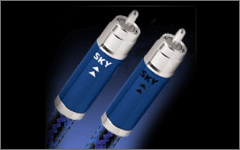
|
SASHA MATSON'S SYSTEM
LOUDSPEAKERS
ELECTRONICS
SOURCES
CABLES
ACCESSORIES
|
2005 marks the 25th anniversary of AudioQuest. That's a real milestone for any company, and especially so for a company that has been an influential and creative part of the high-end audio community since day one. 25th anniversaries we know are Silver Anniversaries; a time then to reflect on what this company has accomplished. What more appropriate way than by listening their Perfect-Surface Silver cables, like the current Sky interconnects?
I wish to state right up front, that I view this article as really an appreciation of AudioQuest, past and present, as opposed to a totally strict 'objective' review. The reason for this: it was Joe Harley and Bill Low of AudioQuest who personally introduced me to the world of high-end audio in 1992, when I recorded an album of my compositions that was released by their then in-house label, AudioQuest Music. (Plug time: that album is still available from Amazon or Acoustic Sounds, and is entitled Steel Chords/I-5 - AudioQuest Music AQ-CD1013).
Recording that music marked the first time I was actually exposed to a direct empirical audio comparison: at Ocean Way studios in Hollywood. Joe Harley of AudioQuest had brought in some long solid silver microphone cables that he ran instead of whatever the regular studio cabling was. Then he directly A/B'd it for me—and I could hear the difference! So that was the start of a continual process of living with AudioQuest gear since that time. The current AQ cables in my system mark the fourth generation of their cables I have continually owned and listened to since 1992. I think this does give me a certain cohesive sonic perspective, in evaluating both the evolution of the AudioQuest cable line, and my own listening system and musical experiences.
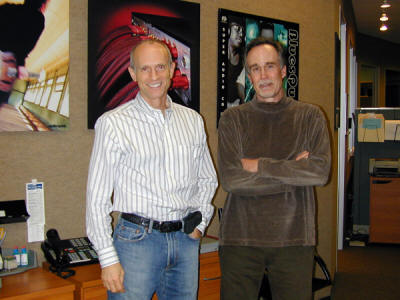
Bill Low and Joe Harley of AudioQuest
Bill Low, CEO-Designer, created AudioQuest in 1980, and does a fine job of recounting the history of that evolution on their current website. I recommend going there directly and reading about the company history at http://www.audioquest.com There are several key principles stated there that have guided AudioQuest's development over the years, among them: "Basic priorities were established as a result of empirical experience and not by abstract theorizing." In fact, in 1987 Bill Low published a paper titled "Cable Design: Theory Versus Empirical Reality." This philosophy has had implications for Bill Low's cable designs throughout the 25 years AudioQuest has been in business, and it certainly applies to his current generation of Dielectric-Bias System cable designs.
In speaking recently with Bill Low, it became clear that the man practices what he preaches. His technical expertise is obviously at a high level, and it also seems to me that Bill has not lost the creative side of the equation—he is not afraid to look at things in new ways. In bringing the Dielectric-Bias System to the marketplace, Bill Low and AudioQuest have certainly applied new design thinking in a concrete, and I think important, manner.
Bill Low and AudioQuest do have a conundrum on their hands: the Dielectric-Bias System is both simple and elegant in practice, and also quite challenging, (at least for this author), to actually analyze and verbalize about. If you look at the AudioQuest full-page ads recently in Stereophile, the headline is "incredibly simple." This is followed by five paragraphs in small print, which explain this apparently simple matter. Bill Low himself in my interview with him (see my interview with Bill elsewhere in this issue of PFO), spoke of trying to find appropriate 'lay' language to convey what is happening. I also feel he has hit on an important point when he states that "the reviewing community, people who aren't actually going to go design and manufacture the product, in many ways are better off turning off their brains and just listening." That empirical type of approach is mothers-milk to these ears, as I am not a technician—I'm a musician and a composer.
It's a trickle-down economy my friends, and there's even such a thing as trickle-down reviewing. A couple of months ago my buddy Art Dudley, Editor-At-Large of Stereophile, who lives 15 miles away from me here in up-state New York, showed up at my front door with a box of current AudioQuest cables he had been reviewing. (See Art's review, and Bill Low's response, in the August 2004 issue of Stereophile, Vol.27, No.8). When I found out Art still had them, I had phoned up Joe Harley at AudioQuest and asked to take another pass at them. Included in my grab-bag box were AQ Sky and Cheetah interconnects, and a pair of Mont Blanc speaker cables. All of these are current AudioQuest models employing the DBS approach.
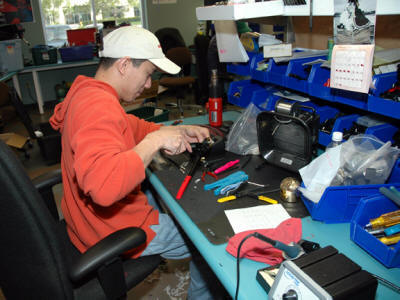
AudioQuest Cable Assembly In Action
Here is a brief rundown on what these three different models of cables consist of, though again I refer you to the AudioQuest website for further details:

The Sky interconnect is the top of the line in AudioQuest's current models. It contains three 20 AWG 'Perfect-Surface Silver' conductors, Teflon air-tubes surrounding the conductor (which are larger than the next-model down Cheetah ), the DBS anodes and cathodes which are connected to two 36-volt external battery packs (that's a total of 72 volts for each cable), attached to one end. The battery pack supplied includes a test button.
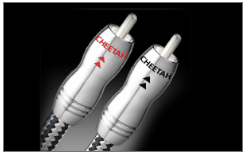
The next model in interconnects from AQ is the Cheetah and it also employs 'Perfect-Surface Silver' in a 3-conductor array, the gauge of those being slightly different at a stated 21 AWG. AudioQuest terms the conductor array 'Triple-Balanced.' Teflon air-tubes are employed as in the Sky model to minimize dielectric involvement. However in the Cheetah model those tubes contain a third less air, so the Teflon dielectric is a little more intimate with the conductors. In the Cheetah model a single 36-volt battery pack is supplied.
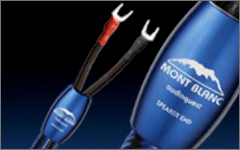
The Mont Blanc speaker cables, which also feature DBS technology, are part of AQ's current 'Earth Feature Series.' In this case, this model is the second rung up on the current line-up of five speaker cable models in the series, the top-of-the-line being the Everest. The Mont Blanc features 'Perfect-Surface Copper' conductors. The positive conductors employ what AQ terms 'Spread-Spectrum Technology,' and each of the two spirals includes five conductors employing four different sizes, in order to avoid any specific sonic signatures associated with any single size. The positive and negative conductors are arrayed in a "counter spiraling geometry." AQ describes it thus: "Earth Feature cables have an inner circular array of positive conductors spiraling in one direction. Around the inner group are the negative conductors, spiraling in the opposite direction." The DBS technology is applied to the speaker cables in the same manner as it is to the interconnects, and the Mont Blanc model employs an attached 36-volt battery pack. A DBS' field element' runs through the center of the cable, and a separate DBS field element outer layer surrounds all the conductors, followed by the outer jacket of the cable, which in the case of the Mont Blanc is a very attractive sky blue color.
All three of the above-mentioned cable models employ very high quality terminations, and these interconnects are available in either balanced or unbalanced formats.
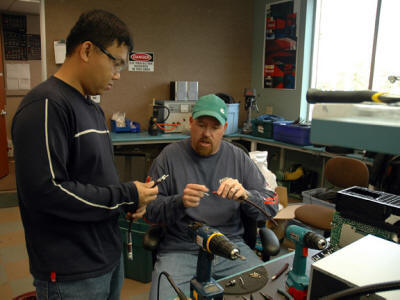
The Men of AQ Do Their Thing
I wanted to make sure that I understood directly from AudioQuest what was necessary in order to get a meaningful A/B evaluation going directly on the merits (that is to say, with my ears) of the Dielectric-Bias System approach. The way to do this, I was told by Joe Harley, was to get matched pairs of cables and listen to them with one pair having been disconnected from the DBS battery pack for several weeks, and the other pair actively connected for a similar time. According to Bill Low it does take time for the cables themselves to move from one state to another—it's not simply a matter of disconnecting the battery and listening to the same cable that will tell you if there's a sonic difference.
So I did do this kind of A/B comparison with matched pairs of both the Sky and the Cheetah single-ended interconnects. I only had on hand one set of Mont Blanc speaker cables, that also utilize the DBS hardware, and they have been continually in my system during this listening period.
It's time for me to try and explain as clearly and simply as I can, what is going on mechanically and electrically with the Dielectric-Bias System hardware. (But please do read my interview published elsewhere in this issue of PFO with Bill Low, where you can hear it from the horse's mouth.) On the simple side of the equation is the hardware itself: a battery pack is mounted to an audio cable with the positive pole of the battery connected to a dedicated separate internal conductor within the cable. This conductor has no electrical interaction with the audio signal conductors—it is entirely separate. From AQ: "Depending on the model of interconnect… an existing shield or outer spiral of conductors is used as the DBS cathode by connecting it to the negative at the DBS battery pack." In plain junior-high school electric shop language, we've got a circuit that is not complete, ergo, there is no drain on the battery pack and therefore the battery pack will rarely need to be replaced. It is not electrically active as some other current cabling approaches call for.
So what is the DBS hardware doing? That's the 64-dollar question! As Bill states in my interview with him, "Dielectric involvement, which is the problem that DBS is addressing, I am quite comfortable has some fuzzy things around the edge… but I am quite comfortable with the phenomenon of dielectric involvement." This is where the benefits of an empirical approach kick in. We can always "stand up and use your ears like a man!"—which is what Charles Ives is reported to have said at a concert of his own music to a restless crowd.
I hate to put words in the mouth of a guy like Bill Low, but here goes: distortion in audio cables is not simply related to transmission of energy and frequencies; it is related to those things over time, which Bill calls "time delay." This is related to the physical nature of cables; their borders or 'skins', the materials used to construct them, and the state in which the materials repose—which is where the DBS battery packs come in. As AQ states in their literature, "All insulation is a dielectric when in the presence of an electric field." And these 'active' and 'passive' materials interact. How they do so, and to what degree, creates the behaviors that the Dielectric-Bias System addresses. And it is important to recognize that these behaviors have definite effects on the ability of components, in this case audio cables, to transmit and convey musical information.

Life in the AQ Warehouse
You can use whatever metaphors you can come up with to describe it—but the end-result of this patent-pending approach, is an improvement in the electrical and mechanical behavior of conductors, i.e. cables, which yields tangible aural and musical benefits. If 'time delay' can be reduced, then one is getting a more coherent sonic picture- more in focus, with less musical fatigue caused by spurious information and erroneous harmonics.
For me, this boils down to something like: 'I may not understand why, but I understand what.' If the shoe fits, wear it. If it sounds good, listen to it. And I am comfortable with that. Who among us can explain the intricacies of digital hardware for example—does this stop audiophiles from happily buying and commenting on such things? Of course it doesn't. But everyone seems to think cables are a no-brainer. I guess that is why there are so many small start-up cable companies, followed by speaker manufacturers. And the reality of course may be different. Who ya gonna call?! I know who I'm comfortable calling, and that's AudioQuest—who have been pursuing sonic excellence through their cable and other hardware designs for 25 years now.
The question before us is: is there a noticeable positive difference between AudioQuest cables in a proper A/B comparison with, and without, the Dielectric-Bias System being active? To answer this, one must first state that AQ cables without DBS are still very fine. The current generation of the AQ product line is outstanding, in terms of choices available, and bang-for-the-buck factors. You should know that AQ starts the lineup for cables that utilize the DBS system at $300 per one meter pair for interconnects, and $400 per 8 foot pair for speaker cabling. Both of these price points are really an incredible bargain in terms of value-added.
Where I was coming from, compared to where I have gotten to, is a big step up, even if DBS was not a factor. I had been using AQ Coral interconnects for several years now, and been a real happy camper! And these are not even at the 'upper' end of the AudioQuest line. So to jump to a silver interconnect like the Sky is, in and of itself, a huge step up. But there's more, and I've heard it with the DBS added to the mix.
Let's talk about relativity for a moment. I gave an academic colleague of mine an extra pair of my AQ Coral interconnects. This guy is a fine jazz musician with real ears, and a fairly modest sound system. So I asked him to A/B those for me with whatever wires he had in there before, and tell me what he heard. Guess what? He sounds just like me right now! He was raving on about what a huge improvement he heard in this and in that. The same metaphors we all grope for, when we hear something that sounds new and great and musical. So improvements in an audio playback system are relative to a listener's experience. And my experience has taken progressive leaps forward over the years because of companies like AudioQuest. This consistency means something to me, rather than endlessly swapping random pieces of gear in and out. I read and respect the fine reviewers out there who do that on a regular basis, but for me, I'd rather find manufacturers who make products that I really love, and stick with them over time. (And a peek into the crystal ball indicates I will be doing something very similar again with Cary Audio for the next PFO issue….)
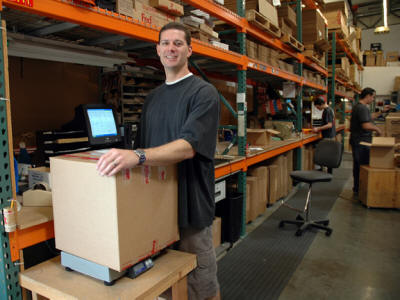
Time To Pack It Up
A/B Comparisons, With and Without Dielectric-Bias System
Here are some notes from what I've heard, by physically comparing matched pairs of AQ Sky and Cheetah interconnects. During this period I was enjoying hearing an E.A.R. 890 tubed amp that Art Dudley loaned me, so he could audition my Cary/AES Sixpac monoblock amps. Art has also been spending intensive time with big Lamm monoblocks recently—you know, sort of like the wizard Saruman spending a little too much time staring into those Palantir balls? But, I digress. Here are my notes:
With the DBS battery packs connected to one pair, and disconnected from the other pair beforehand for some time, I had two matched pairs of AQ Sky and two matched pairs of AQ Cheetah interconnects to compare, coming from my Cary 308T CD deck, and listening as well through the AQ Mont Blanc speaker cables, which did have the DBS units engaged throughout.
With DBS: The Reiner Sound, Reiner - Living Stereo
One of my first choice references, and I'm sure one of many of yours. The way those delicate muted tremolo strings softly sneak in at the opening of side one with the Ravel, tells me a lot about sound system quality. Especially off the Classic Records vinyl version, but also not too shabby off the JVC-XRCD redbook CD.
1.) Far more glistening upper violin partials.
2.) Clearer better defined contrabasses.
3.) Muted trumpet entrances more audible.
4.) Stage noises of the string mutes being taken on and off more apparent.
5.) More 'life' from the fluttering winds.
With DBS: La Rondine, Pappano - EMI
One of the more gorgeous modern-era CD releases from a few years back. There has been progress in digital recordings, we need to give credit when it is due, and this recording is one of those. There is a wonderful Puccini-at-his-sexy-best soprano aria, (Track 3 on Disc 1) "Chi bei sogno di Doretta" that the character Magda sings. It's one of the main themes of the opera, and when I heard this last year at the Montreal Son & Image show on Verity Audio's then-new Sarastro speakers, that sound just got up and floated around the room; people were bursting into tears all around me. Verity were running the best gear money can buy, and those Sarastro speakers are fantastic. Well, I was hearing plenty of that same mojo again in my own living room!
1.) Lovelier muted strings with more dynamics.
2.) High sustained pitches were less muffled.
3.) Vocal more clearly doubled by the strings with more sonic differences.
4.) Stage depth increased.
5.) Intelligibility of the diction increased.
6.) Temporal flow expanded—a sense of time moving more slowly.
Then I went the other way; I took notes listening to recordings with attention paid primarily to the sound when the cables had been disconnected from the DBS battery packs for some time.
Without DBS: All I Had Was the Blues, Doug MacLeod - AudioQuest Music/JVC
Getting even more 'into bed' with AQ, this is one of the very finest of producer Joe Harley and engineer Michael C. Ross's much-praised recordings. Here I was listening to the redbook CD version that Joe Harley himself was involved in re-releasing on those super-fine JVC-XRCD discs. From the album "You Can't Take My Blues", this particular cut is highly intimate- just acoustic bass, and Doug singing his heart out and playing a very soulful bottle-neck on what sounds like a Nashville steel guitar, or maybe a dobro, though that information isn't listed. Again, without the DBS I heard:
1.) Less of those glistening steel guitar/bottleneck sliding harmonics.
2.) The acoustic bass had less definition and attack in its deep low ringing notes.
3.) Less sustain on the guitar.
4.) Less tangible sense of the interplay of fingers and strings—which is very much a great part of the sound on this track.
5.) Doug's voice was less 'emotional' (I know this is a floppy concept—but that's what the harmonic series delivers to me when its properly re-created—the emotional energy of the music at hand.).
Without DBS: Too Proud, Mighty Sam McClain - AudioQuest Music/JVC
If I have to pick one favorite of Joe and Michael's great recordings for AudioQuest music, (other than my own of course), it's this one that followed immediately after the one we did together. Recorded in the same room, Studio B at Ocean Way in Hollywood, using as much direct-to-Ampex ½-track production as possible. This recording is quite well known, and rightly so- it sounds great, and it's great music! One of the many standout qualities of this album is the sound of the Hammond B-3, simply the best recording of that instrument I've ever heard, and I own quite a bit of B-3 jazz on vinyl and CD.
1.) Less 'glisten' from Bruce Katz's gold-standard B-3 sound.
2.) Soundstage not as wide.
3.) Attack of (Fender?) guitar less present.
4.) Less 'red-clay' on the vocal from Mighty Sam.
5.) Less punch from the drums.
6.) Less low-end extension.
7.) Less musical energy in the 'pay-off' at end of song.
Then I swapped the DBS cables back in and made the following notes:
With DBS: (same recording)
1.) Great initial punch from drums and bass.
2.) Beautiful glisten from the slow Leslie.
3.) More 'room' around Mighty Sam.
4.) More sense of drum heads actually being hit.
5.) A wider deeper soundstage.
6.) Very soulful guitar, with more fret and pick envelopes.
7.) Great sense of pent-up energy being released.
Then I listened from my turntable, which is a Rega-25 without detachable cables. So I was listening to one pair of AQ Sky interconnects only—from the preamp to the amps. And I swapped those matched pairs and compared.
With DBS: Walk Across the Rooftops, Blue Nile - A&M
This album is another of my references. I have it on CD, but the vinyl is vastly superior, with a very multi-layered subtle approach to the artificial studio-generated soundworld that has rarely been equaled. As many know, this album was done in collaboration with the Linn company, and it shows. The better your music playback technology, the more you will hear on this recording; I've heard it happen over the years as I improved my system.
1.) Tighter bass—more fret definition.
2.) More air/reverb around the 'strings'—which still intrigue me, as they sound like a combination of synth and acoustic sources.
3.) Descending piano arpeggios have more pitch content and better attack.
4.) Far more ambient stuff (of which there is no shortage on this album).
5.) More clear diction on the vocal, more emotion too.
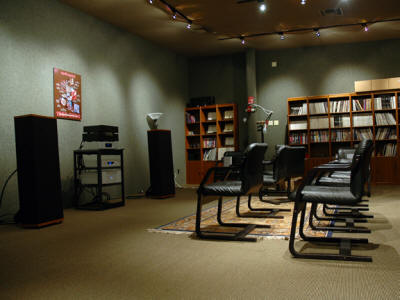
The AudioQuest Listening Room
Living With DBS
Now that I've had the AudioQuest DBS cables in my
system for some time, I still am constantly amazed every time I pull out a
recording that I haven't heard in a while. These AQ cables with DBS have taken
me out to a whole new ballgame! It really has been on the order of a major
component upgrade. Quite frankly I wasn't expecting this,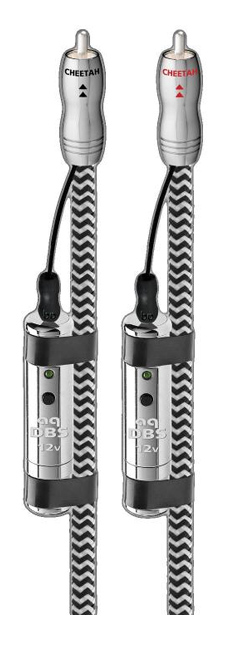 but as I told Bill
Low, "It's nice when it happens!" If you consider the upper end of the current AQ DBS cable line-up from your budget viewpoint, whatever that may be, and
understand that you are talking about a musical difference on the order of fine
amps, preamps, turntables, loudspeakers, etc., then the budget will start making
a whole lot of sense. I didn't understand that truly until now myself, but I've
got the picture loud and clear now!
but as I told Bill
Low, "It's nice when it happens!" If you consider the upper end of the current AQ DBS cable line-up from your budget viewpoint, whatever that may be, and
understand that you are talking about a musical difference on the order of fine
amps, preamps, turntables, loudspeakers, etc., then the budget will start making
a whole lot of sense. I didn't understand that truly until now myself, but I've
got the picture loud and clear now!
Bill Low rates the idea of 'fatigue' quite highly in importance, and now that I've listened extensively with the DBS gear, I do hear what he is getting at. Another term might just be plain old 'boredom.' If you are tired of the overall sound you are getting, your music seems un-engaging, it's just not fun any more—you really owe it to your ears to give the DBS approach a try. I was conversing with Dennis Had, CEO and Designer for Cary Audio about similar concerns recently. I mentioned to both Bill and Dennis a perception that I've had for some time, that when the domain of music playback we call 'high-end' is really working, when the pieces all come together, and one is in touch with the music- then time itself seems to slow down. Allow me to call it time expansion. I have the sense listening to music through the current AQ DBS cables that the tempo of the music has slowed down. And I do not mean this in a negative way—on the contrary—it is a bit of the same magic that I know and value from the creative process itself. Have you ever looked up and found you had lost track of time, because whatever you were doing was so engaging? When that happens it feels as if there's simply more time, or that the time seemed to be passing more slowly than the clock indicated. This is another kind of relativity, which actually is my little personal empirical verification that Einstein is correct after all! And it is a question of relativity in action on a number of levels—these things are subjective and personal and not easily quantified.
I now use the term music re-creation, instead of the more common audio term 'reproduction,' in order to try and indicate this quality in audio playback, when the playback is at a level of excellence where this phenomenon of 'time expansion' occurs. And it occurs because of many subjective aural phenomenon; if you are paying closer attention to a piece of music because you hear more, and what you are hearing sounds better, you receive more emotion from that music and become more involved, and then- bingo! The magic kicks in!
Having made enough disclaimers, I'm here to tell you that Bill Low and AudioQuest, through the Dielectric-Bias System designs, have brought the state of audio re-creation to an even higher plane than has previously been possible. It goes back to the first article I wrote for the then-print journal Positive Feedback, in which I floated the idea of high-end composing. (Interested readers will find the article that Sasha is referring to in Vol. 7, No. 4 of Positive Feedback; it's in the PFO archives at www.positive-feedback.com/pfbackissues/0704/matson.7n4.html.) What I meant by that, and still do, is that for me the creation, performance, recording, and the re-creation of music are all directly linked. And when it really gets good, that's when we can feel that link. I've had the privilege of hearing my own music from those different vantage points. And this gives me the reference frame to be able to say: "There it is, there's mezzo soprano Catherine Robbin standing in the Schnee Studio, singing my music, and that is what it sounded like! I'm able to go there now, in a way that I was not able to previously. And the AudioQuest people that have helped me get there, are people that have really great ears, and are as passionate about music as I am—people like Joe Harley and Bill Low. You should just take my word on this: no junky sound is going to get by these folks!
I did read recently Issue 17 of Positive Feedback Online with great interest. In it are Bob Levi and Max Dudious's very enthusiastic reviews of new audio cables from Harmonic Technology (see Dudious, Levi, and Levi again), cables that employ a fiber optic-based technology. In the spirit of healthy debate and conversation that PFO stands for, I invited these colleagues (and I likewise invite anyone else from the larger PFO community) to consider evaluating these two new technologies with me in a direct comparison. In fact, I asked Bill Low for his views on this, and he was happy to respond, having designed fiber-optic cables himself.
(Please see my interview with Bill elsewhere in this issue for the content of Bill's thoughts about fiber-optic audio cables.)
All I can add to this debate at this point, (if it is a debate), is to say that everything they say they are hearing with that approach in their systems, is what I say I am hearing in my system with the AQ DBS cables. If it's a silver bullet you're looking for, you might look inside a Sky interconnect! And I would point out as well that I am not simply listening to 'metal'; the Dielectric-Bias System adds a whole other dimension to the way in which the sonic and musical end-results are achieved by these AudioQuest cables. My hunch is that both of these new approaches, different as they may be, may in fact have taken us all further musically than was heretofore possible—which is a good thing! I look forward to that 'Follow-Up' in PFO, to borrow a Stereophile phrase.
Ye Olde Editor David Robinson confirmed that I am the first to review AudioQuest gear for Positive Feedback since David did so in the first year of the print era of the magazine, a fact that I find to be somewhat odd. I know I am the first one to comment on the new AQ DBS technology. Why is this? "Small and inexperienced" in an audio firm does not necessarily equal "better." I personally am very attracted to designers and companies that 'have legs,' that have paid dues, that stand by their products, and continue to evolve them over time. "AudioQuest has been the largest cable supplier to the high-end specialist market for many years." This simple statement is on the AudioQuest company website, and I have no reason to assume that it is not the case. That is a considerable achievement, and not to be discounted—there are reasons AudioQuest has been so successful over the years.
So happy 25th anniversary Bill, Joe, and everyone at AudioQuest! They are to be saluted for making the world a better-sounding place—for humanizing the technology. AudioQuest Dielectric-Bias System cables are a brilliant, elegant, and important breakthrough in audio—they breathe new life into the re-creation of music. DBS, and the current outstanding AudioQuest products that utilize this technology, bring powerful new empirical magic to the audio world—they allow the emotional imperatives of music to connect as never before. Sasha Matson
AudioQuest Sky DBS interconnect
cable
Retail: $2100 per one meter pair
AudioQuest Cheetah DBS interconnect
cable
Retail: $1000 per one meter pair
AudioQuest Mont Blanc DBS
speaker cable
Retail: $2125 per 10 ft. pair
AudioQuest/CinemaQuest
8710 Research Drive
Irvine, CA. 92618
TEL: 949. 585. 0111
web address:
www.audioquest.com
